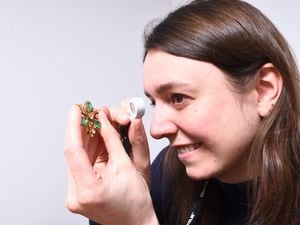Home is where the art is for virtuoso Malcolm
Creative inspiration can come from the most unlikely of sources. For Malcolm Tillis, it was in an old tea chest he bought for a few pounds in a second-hand furniture auction.

"I had just come back to Britain after living abroad, and needed some furniture," he recalls.
"I bought this old tea chest in an auction for about £4, and it had some old cork tiles in it. I hate seeing anything wasted, so I used it to create some art work."
That was in 1984, and that discovery in an old tea chest led to a new chapter in Malcolm's already colourful artistic career. It has also brought him international recognition from one of the world's leading art experts, who says Malcolm's avant-garde collages will see him one day ranked alongside the greatest abstract artists in history.
F Lanier Graham, former curator of the New York Museum of Modern Art, has been championing Malcolm's work for some years.
"What Tillis has done is far beyond exceptional," he says.
"From a quiet corner of England has come a profound affirmation of humanity, a precious gift to the history of art.
"When the definitive history of abstract collage is written, I predict that there will be a chapter on what Schwitters did in Germany, what Arp did in France, what Motherwell did in the United States, and what Tillis did in England."
That old tea chest still stands in the studio at the top of Malcolm's three-storey terraced house on the outskirts of Shrewsbury. At the moment it forms a desktop where he is painting wallpaper to create his latest collages.
"Everything I do is recycled, people have given me this wallpaper because it is the perfect texture," he says.
At the moment he is holding an exhibition to raise money for Age UK Shropshire Telford & Wrekin. He says, at the age of 90, it will definitely be his last.
Malcolm has long run out of wall space at his home to display all his art, and even as he prepares for his 91st birthday, he shows few signs of slowing down.
"I can work through the night," he says.
"I've always been an artist, if I do something I have to give it my all."
Malcolm has led an eventful life, to say the least. A talented viola player, he began his career at the world-renowned Halle Orchestra, working with the likes of Benjamin Britten, Sir William Walton and Sir John Barbirolli. But his career was brought to a sensational end in 1960 by his best-selling book Chords and Discords.
His no-holds barred account of life behind the scenes in one of the world's most famous orchestras certainly proved compelling reading, but it also created a national scandal which resulted in Malcolm fleeing the country to escape the furore. Then during the quarter of a century he lived abroad with his novelist wife Kate, he reinvented himself as a visual artist, exploring the new techniques in modern art.
"As a young man I always wanted to be a musician, I loved the music," he says.
"It was wonderful because all the big conductors of the time would come to the Halle. William Walton was the greatest English living conductor at the time, as well as a great composer."
His career as a musician would be short-lived, though, coming to an abrupt hall after he took a year's leave of absence to write his controversial book.
"Sir John Barberolli, who was the principal conductor, knew I was writing a book, and he gave me a year's leave of absence in 1958 to write it," he says.
But his portrayal of the poor pay and conditions, the lack of rest and the hours spent travelling the country as the orchestra tried to pack as many venues in as possible, was not at all well received by Barberolli.
"I was 31, and at that age I was very naive," says Malcolm.
"It was never a criticism of Sir John, but he wouldn't speak to me after that.
"I thought if you told the truth people would respect you for it, but they didn't like the fact that I told it how it was.
"The book went into the best-sellers list, and I was on national television three times in 10 days, it was on the front pages of all the national papers. By then, I realised my career as a musician was over."
The publication of the book sparked a national storm about life in the orchestra. Three members resigned, Sir John threatened to resign, and Malcolm was sent a solicitors' letter warning him of imminent legal action if he repeated any of his claims.
"My wife Kate said it was time to get out of the country to get away from all the fuss, so we moved abroad."
Malcolm had met novelist Kate Christie while on the island of Ischia, near Naples. Kate lived on the island, and Malcolm was on holiday, and Kate who was already a successful writer, had encouraged him to write about his experiences.
"The orchestra was world renowned, and the conductors were huge stars, but the ordinary museums were extremely poorly paid, and worked in terrible conditions."
After the controversy about the book, Malcolm moved to Ischia with Kate. The couple later lived in Ibiza and India, and by this time Malcolm's artistic endeavours were already moving into a different direction.
"Before I went to Ischia I was already working with all these beautiful silks," he says, pointing to one of his earliest examples of batik art hanging on his landing.
"I was using a lot of colours in the 1960s," he says. Batik is a technique particularly popular in Asia and parts of Africa, where designs are drawn onto the silk in wax before the cloth is dyed.
But it is his collages which have come to define his career.
According to Graham, "His interlocking motions are magically musical, his colours leap up into light. His visions are visions of ecstasy.
"I know of no abstract artist alive today in any country whose art is more lyrical."
Malcolm's exhibition runs until 28th September at the temporary "pop up" street gallery at 18-19 Shoplatch in Shrewsbury, which is run by the Visual Art Network. Malcolm will be donating 20 per cent of the takings from the sale of his work to Age UK Shropshire Telford & Wrekin.
Heather Osborne, chief executive of Age UK Shropshire Telford & Wrekin says: “I have seen some of Malcolm’s work in the gallery and we are very grateful for his generosity.
"It is lovely to see a man in his later years still active and enjoying his work. I would urge people to go along to visit the exhibition – it is really impressive.”





